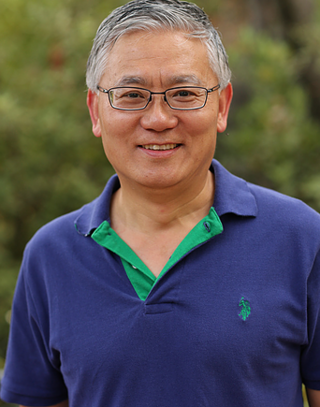Related Research Articles

Fitts's law is a predictive model of human movement primarily used in human–computer interaction and ergonomics. The law predicts that the time required to rapidly move to a target area is a function of the ratio between the distance to the target and the width of the target. Fitts's law is used to model the act of pointing, either by physically touching an object with a hand or finger, or virtually, by pointing to an object on a computer monitor using a pointing device. It was initially developed by Paul Fitts.
Personal information management (PIM) is the study and implementation of the activities that people perform in order to acquire or create, store, organize, maintain, retrieve, and use informational items such as documents, web pages, and email messages for everyday use to complete tasks and fulfill a person's various roles ; it is information management with intrapersonal scope.

Eric Paulos is an American computer scientist, artist, and inventor, best known for his early work on internet robotic teleoperation and is considered a founder of the field of Urban Computing, coining the term "urban computing" in 2004. His current work is in the areas of emancipation fabrication, cosmetic computing, citizen science, New Making Renaissance, Critical Making, Robotics, DIY Biology, DIY culture, Micro-volunteering, and the cultural critique of such technologies through New Media strategies.
In computing, post-WIMP comprises work on user interfaces, mostly graphical user interfaces, which attempt to go beyond the paradigm of windows, icons, menus and a pointing device, i.e. WIMP interfaces.
A pervasive game is one where the gaming experience is extended out in the real world, or where the fictive world in which the game takes place blends with the physical world. The "It's Alive" mobile games company described pervasive games as "games that surround you", while Montola, Stenros and Waern's book, Pervasive Games defines them as having "one or more salient features that expand the contractual magic circle of play spatially, temporally, or socially." The concept of a "magic circle" draws from the work of Johan Huizinga, who describes the boundaries of play.
The Special Interest Group on Computer–Human Interaction (SIGCHI) is one of the Association for Computing Machinery's special interest groups which is focused on human–computer interactions (HCI).
The Conference on Mobile Human-Computer Interaction (MobileHCI) is a leading series of academic conferences in Human–computer interaction and is sponsored by ACM SIGCHI, the Special Interest Group on Computer-Human Interaction. MobileHCI has been held annually since 1998 and has been an ACM SIGCHI sponsored conference since 2012 The conference is very competitive, with an acceptance rate of below 20% in 2017 from 25% in 2006 and 21.6% in 2009. MobileHCI 2011 was held in Stockholm, Sweden, and MobileHCI 2012 which was sponsored by SIGCHI held in San Francisco, USA.
Urban computing is an interdisciplinary field which pertains to the study and application of computing technology in urban areas. This involves the application of wireless networks, sensors, computational power, and data to improve the quality of densely populated areas. Urban computing is the technological framework for smart cities.
Microsoft Mouse Mischief is an add-in to Microsoft Office PowerPoint 2010 and 2007, the presentation program by Microsoft that is part of the Microsoft Office system. It runs on the Microsoft Windows operating systems Windows XP SP3, Windows Vista and Windows 7. This program will enable teachers to create and insert questions, polls, and drawing activity slides into Office PowerPoint lessons. When the lessons are played, students can actively respond to these slides, individually or in teams, by using their own mice to click, circle, cross out, color in, or draw answers on the screen.
HomeOS was the working title of a home automation operating system being developed at Microsoft Research in the early 2010s. Microsoft Research announced the project in 2010 and abandoned it in 2012.

Jean-Daniel Fekete is a French computer scientist.

Projector-camera systems (pro-cam), also called camera-projector systems, augment a local surface with a projected captured image of a remote surface, creating a shared workspace for remote collaboration and communication. Projector-camera systems may also be used for artistic and entertainment purposes. A pro-cam system consists of a vertical screen for implementing interpersonal space where front-facing videos are displayed, and a horizontal projected screen on the tabletop for implementing shared workspace where downward facing videos are overlapped. An automatically pre-warped image is sent to the projector to ensure that the horizontal screen appears undistorted.
Animal–Computer Interaction (ACI) is a field of research for the design and use of technology with, for and by animals covering different kinds of animals from wildlife, zoo and domesticated animals in different roles. It emerged from, and was heavily influenced by, the discipline of Human–computer interaction (HCI). As the field expanded, it has become increasingly multi-disciplinary, incorporating techniques and research from disciplines such as artificial intelligence (AI), requirements engineering (RE), and veterinary science.

Wendy Elizabeth Mackay is a Canadian researcher specializing in human-computer interaction. She has served in all of the roles on the SIGCHI committee, including Chair. She is a member of the CHI Academy and a recipient of a European Research Council Advanced grant. She has been a visiting professor in Stanford University between 2010 and 2012, and received the ACM SIGCHI Lifetime Service Award in 2014.
Joëlle Coutaz is a French computer scientist, specializing in human-computer interaction (HCI). Her career includes research in the fields of operating systems and HCI, as well as being a professor at the University of Grenoble. Coutaz is considered a pioneer in HCI in France, and in 2007, she was awarded membership to SIGCHI. She was also involved in organizing CHI conferences and was a member on the editorial board of ACM Transactions on Computer-Human Interaction.
Andrew Cockburn is currently working as a Professor in the Department of Computer Science and Software Engineering at the University of Canterbury in Christchurch, New Zealand. He is in charge of the Human Computer Interactions Lab where he conducts research focused on designing and testing user interfaces that integrate with inherent human factors.

Shumin Zhai is a Chinese-born American Canadian Human–computer interaction (HCI) research scientist and inventor. He is known for his research specifically on input devices and interaction methods, swipe-gesture-based touchscreen keyboards, eye-tracking interfaces, and models of human performance in human-computer interaction. His studies have contributed to both foundational models and understandings of HCI and practical user interface designs and flagship products. He previously worked at IBM where he invented the ShapeWriter text entry method for smartphones, which is a predecessor to the modern Swype keyboard. Dr. Zhai's publications have won the ACM UIST Lasting Impact Award and the IEEE Computer Society Best Paper Award, among others, and he is most known for his research specifically on input devices and interaction methods, swipe-gesture-based touchscreen keyboards, eye-tracking interfaces, and models of human performance in human-computer interaction. Dr. Zhai is currently a Principal Scientist at Google where he leads and directs research, design, and development of human-device input methods and haptics systems.
Tawanna Dillahunt is an American computer scientist and information scientist based at the University of Michigan School of Information. She runs the Social Innovations Group, a research group that designs, builds, and enhances technologies to solve real-world problems. Her research has been cited over 2,700 times according to Google Scholar.
Batya Friedman is an American professor in the University of Washington Information School. She is also an adjunct professor in the Paul G. Allen School Computer Science and Engineering and adjunct professor in the Department of Human-Centered Design and Engineering, where she directs the Value Sensitive Design Research Lab. She received her PhD in learning sciences from the University of California, Los Angeles School of Education in 1988, and has an undergraduate degree in computer science and mathematics.
Jofish Kaye is an American and British scientist specializing in human-computer interaction and artificial intelligence. He runs interaction design and user research at anthem.ai, and is an editor of Personal & Ubiquitous Computing.
References
- ↑ A.J. Bernheim; Brush; Bongshin Lee; Ratul Mahajan; Sharad Agarwal; Stefan Saroiu & Colin Dixon (2011). "Home automation in the wild: Challenges and opportunities". Proceedings of the SIGCHI Conference on Human Factors in Computing Systems. pp. 2115–2124. doi:10.1145/1978942.1979249. ISBN 9781450302289. S2CID 14480787.
- ↑ Colin Dixon; Ratul Mahajan; Sharad Agarwal; AJ Brush; Bongshin Lee; Stefan Saroiu & Victor Bahl (2012). "An Operating System for the Home". NSDI'12 Proceedings of the 9th USENIX Conference on Networked Systems Design and Implementation: 25.
- 1 2 Carman Neustaedter & A.J. Bernheim Brush (2006). ""LINC-ing" the family: The participatory design of an inkable family calendar". Proceedings of the SIGCHI Conference on Human Factors in Computing Systems. pp. 141–150. doi:10.1145/1124772.1124796. ISBN 1595933727. S2CID 5611048.
- ↑ Carman Neustaedter; A.J. Bernheim Brush & Saul Greenberg (2007). "A Digital Family Calendar in the Home: Lessons from Field Trials of LINC". GI '07 Proceedings of Graphics Interface 2007: 199–20?. doi:10.1145/1268517.1268551. S2CID 15524852.
- ↑ A.J. Bernheim Brush & Kori M. Inkpen (2007). "Yours, Mine, and Ours? Sharing and Use of Technology in Domestic Environments". UbiComp '07 Proceedings of the 9th International Conference on Ubiquitous Computing: 109–126.
- ↑ Amy Karlson; A.J. Bernheim Brush & Stuart Schechter (2009). "Can i borrow your phone?: Understanding concerns when sharing mobile phones". Proceedings of the SIGCHI Conference on Human Factors in Computing Systems. pp. 1647–1650. doi:10.1145/1518701.1518953. ISBN 9781605582467. S2CID 8645482.
- ↑ Serge Egelman; A.J. Bernheim Brush & Kori Inkpen (2008). "Family accounts: A new paradigm for user accounts within the home environment". Proceedings of the 2008 ACM conference on Computer supported cooperative work. pp. 669–678. doi:10.1145/1460563.1460666. ISBN 9781605580074. S2CID 14507614.
- ↑ Eiji Hayashi; Oriana Riva; Karin Strauss; A.J. Brush & Stuart Schechter (2012). "Goldilocks and the Two Mobile Devices: Going Beyond All-Or-Nothing Access to a Device's Applications". SOUPS '12 Proceedings of the Eighth Symposium on Usable Privacy and Security. doi:10.1145/2335356.2335359. S2CID 14521201.
- ↑ CRA-W (2014-06-26). "Borg Early Career Award". CRA-W. Retrieved 2014-06-26.
- ↑ "Learning Time-Based Presence Probabilities". Pervasive 2011. 2006.
- ↑ Hong Lu; A.J. Bernheim Brush; Bodhi Priyantha; Amy Karlson; Jie Liu. Pervasive (2011). "SpeakerSense: Energy Efficient Unobtrusive". Pervasive 2011.
- ↑ Jonathan Lester; Desney Tan; Shwetak Patel; A.J. Bernheim Brush (March 2010). Automatic Classification of Daily Fluid Intake. 4th International Conference on Pervasive Computing Technologies for Healthcare. Munich, Germany: IEEE. doi: 10.4108/ICST.PERVASIVEHEALTH2010.8906 .
- ↑ A.J. Bernheim Brush & Alan Borning (2005). "'Today' Messages: Lightweight Support for Small Group Awareness via Email". Hicss 2005.